Even with all the widespread support consoles got back in the ’80s and ’90s, there were always going to be games that never got the home port treatment. Be it due to technological limitations or time/budget constraints, every major publisher left at least a few titles in the arcade. Sure, many finally came home in compilations or as downloads for later machines, but they were denied the chance to fall into our eager hands when their buzz was still new. The arcade was the only place to find them. I can remember going to game rooms and scanning the rows for new titles that could end up on my Master System, Genesis, or Saturn. It was a regular practice, and it was exciting to see games that looked like they had a great chance of getting ported.
Irem was one company that always seemed to have more coin-op releases than it could convert. We’ve put together a small selection of games that never made the jump to consoles. This list is by no means comprehensive, and we did get the lion’s share of Irem’s catalog, but it would have been nice to get them all (I’m greedy like that). Some of these titles remained unknown to me for years until the wonders of emulation unveiled them to me. So, let’s take a quick look at some of those games that Irem left in the arcade for some reason. Perhaps there are a few you haven’t yet heard of or haven’t played in a while.
Dragon Breed (1989)
Computer gamers are likely familiar with Dragon Breed, a horizontal shooter that features a teenage king riding a dragon that incinerates everything it sees with its fiery breath. That alone was enough to hook me, but Dragon Breed brought the full package with it anyway. The music rocked, the graphics had that instantly-recognizable Irem style, and the action was plentiful. Dragon Breed didn’t throw it all at players all at once, of course. It started slow, with players only having the prince’s crossbow as their weapon to shoot a few oncoming enemies. Grab that first power-up though, and the dragon roared to life (literally) and emitted a cone of flame from its mouth. Subsequent icons increased the cone’s length and power, but that wasn’t the dragon’s only trick. It could emit lighting from his body, fire missiles, and even kill foes by whipping its tail around and into them. Also, the prince could dismount and run around on his own.
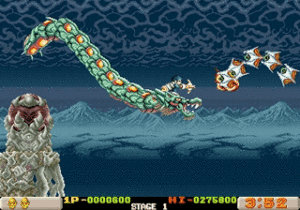 I can’t help but feel that Dragon Breed borrowed a bit from Irem’s fabled R-Type. The graphics were similar, the indestructible dragon body was a lot like the Force Pod, and the third stage even had screen-filling ships whose cannons could be destroyed. Dragon Breed was also brutally difficult, and its six stages were bound to have players running to the change machine often. To clarify, I certainly mean all of this as a compliment. Dragon Breed was by no means an R-Type clone, and it stood on its merit. The game had an incredible ambiance to it, and it was a ton of fun to play.
I can’t help but feel that Dragon Breed borrowed a bit from Irem’s fabled R-Type. The graphics were similar, the indestructible dragon body was a lot like the Force Pod, and the third stage even had screen-filling ships whose cannons could be destroyed. Dragon Breed was also brutally difficult, and its six stages were bound to have players running to the change machine often. To clarify, I certainly mean all of this as a compliment. Dragon Breed was by no means an R-Type clone, and it stood on its merit. The game had an incredible ambiance to it, and it was a ton of fun to play.
Irem only made Dragon Breed available on European computers back in the day. It did appear on the PC collection Irem Arcade Hits in 2011, but the emulation quality reportedly isn’t that good. I do hope Irem licenses it to a future Evercade collection, but that’s not set in stone. MAME remains the best option, and I can wholeheartedly recommend giving it some time. Just be prepared to continue… A LOT.
Lightning Swords (1989)
Lost Swords was a side-scrolling hack-‘n-slash in which players took on the role of the samurai Blue Dragon, who was out to avenge the murder of a woman fleeing from a gang of thugs. While not as fluid or polished as classics like Revenge of Shinobi, Lightning Swords did manage some solid action with a good presentation. The controls might have taken some getting used to, though. There was only a single action button, used for attacking, and players held it down to build up power (up to five grades) for an intense attack. Thus, jumping was done by holding the joystick upwards. Ordinarily, this wouldn’t be a problem, but there were instances where Lighting Swords made players do a bit of platforming, which could be awkward. The wall jump and crouching movements could also be a bit difficult, but thankfully, the learning curve wasn’t too steep. The two-player simultaneous action also made things a bit easier.
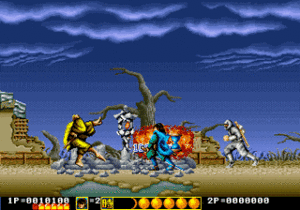 Don’t get the wrong idea about Lighting Swords. The gameplay wasn’t quite as intuitive as it should have been, but overall, the game wasn’t made overly difficult because of it. Irem tossed enough power-ups to make things manageable, and there were unlimited continues. With some practice, two people could hack and slash their way through its 10 stages easily enough. With colorful graphics, a varied soundtrack, and interesting bosses, it wasn’t a bad way to spend a pocketful of quarters.
Don’t get the wrong idea about Lighting Swords. The gameplay wasn’t quite as intuitive as it should have been, but overall, the game wasn’t made overly difficult because of it. Irem tossed enough power-ups to make things manageable, and there were unlimited continues. With some practice, two people could hack and slash their way through its 10 stages easily enough. With colorful graphics, a varied soundtrack, and interesting bosses, it wasn’t a bad way to spend a pocketful of quarters.
While Lightning Swords never came to the Genesis – a shame, as it would have been a great fit – Irem did finally make it available in its excellent Evercade collection in 2022. I’m a major fan of the console, but there’s always emulation if you’re not interested in an official release. Either way, Lighting Swords is a fun game that should be given a chance.
Blade Master (1991)
In the era before Street Fighter II rose to dominance, arcades were overflowing with Double Dragon clones. Hack-‘n-slashers were popular but not quite as common, and it was almost as if every publisher had at least one available. Some were plain 2D, but others adopted the same 3/4s perspective of Double Dragon. For many coin-op fans, Sega’s Golden Axe stood tallest among them, but others came close. Irem threw its hat into the ring in 1991 with Blade Master. As one of two characters, Roy and Arnold, players battled monsters across the seven stages of their homeland to rescue Arnold’s sister, Princess Emina.
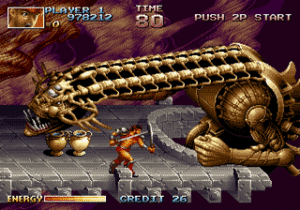 In all honesty, Blade Master was no threat to Golden Axe’s crown, but that doesn’t mean it wasn’t worth playing. The presentation was great, particularly the pixel art and those amazing bosses, and the characters weren’t just palette swaps. Roy used a sword and dagger, and he made up for his short horizontal attack with his great vertical range. Arnold was larger and slower but more powerful. He wielded a spear and flail and was most effective from long range. The standard joystick/2-button control scheme was robust enough to include ripostes and special attacks, and playing with a friend was a lot of fun.
In all honesty, Blade Master was no threat to Golden Axe’s crown, but that doesn’t mean it wasn’t worth playing. The presentation was great, particularly the pixel art and those amazing bosses, and the characters weren’t just palette swaps. Roy used a sword and dagger, and he made up for his short horizontal attack with his great vertical range. Arnold was larger and slower but more powerful. He wielded a spear and flail and was most effective from long range. The standard joystick/2-button control scheme was robust enough to include ripostes and special attacks, and playing with a friend was a lot of fun.
Blade Master was also included in the 2011 Irem Arcade Hits collection, but it completely missed the consoles of its day. I’m sure it would have been a hit had it come to the Genesis or Sega CD. The latter machine could have benefited from a solid hack-‘n-slasher, especially in the West. I know I would have bought it.
Cosmic Cop (1991)
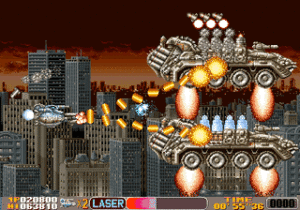 If you were to take R-Type without the Force Pod and challenge and speed up the action, you’d get Cosmic Cop. It checked a lot of the boxes for which shmups of the period were known, and it did it all well enough but not with enough flair to make it memorable like Gaiares or Thunder Force III. Perhaps that’s why it never got a Genesis port. There was already a large selection of shmups on the console by 1991, and Cosmic Cop didn’t do enough to stand out. Still, I found it interesting, and I liked the art style, which is highly reminiscent of Irem’s later shooter, In the Hunt.
If you were to take R-Type without the Force Pod and challenge and speed up the action, you’d get Cosmic Cop. It checked a lot of the boxes for which shmups of the period were known, and it did it all well enough but not with enough flair to make it memorable like Gaiares or Thunder Force III. Perhaps that’s why it never got a Genesis port. There was already a large selection of shmups on the console by 1991, and Cosmic Cop didn’t do enough to stand out. Still, I found it interesting, and I liked the art style, which is highly reminiscent of Irem’s later shooter, In the Hunt.
Cosmic Cop is playable on the aforementioned Irem PC collection, but MAME is probably the best way to play it. I’d recommend at least giving it a try, at least for the pixel art.
Lethal Thunder (1991)
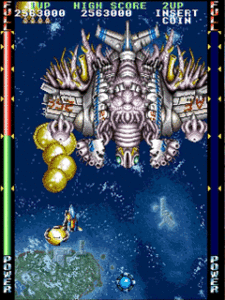 A few minutes with Lethal Thunder will have many shmup fans thinking of Taito’s RayForce, though Irem’s product preceded it by three years. The latter likely took inspiration from Lethal Thunder for style and design, and that’s not a bad thing. Irem itself seemed to have been influenced by the Seibu Kaihatsu classic Raiden, merely transferring the gameplay to space. For the most part, it works, with four different weapon power-ups ranging from flamethrowers to the standard spread shot. One element that Irem added was increasing shot size depending on how fast the fire button was pressed. A power gauge on the left side of the screen slowly filled as one fired, until it completely charged and could be released as a screen-filling explosion. Granted, one could question the wisdom in making players pound the fire button repeatedly – it couldn’t have been pleasant for either the player or the machine – but the gameplay gimmick did stand out in the sea of shmups that flooded the market at the time. Moreover, the inclusion of simultaneous two-player action added another layer to the already hectic action.
A few minutes with Lethal Thunder will have many shmup fans thinking of Taito’s RayForce, though Irem’s product preceded it by three years. The latter likely took inspiration from Lethal Thunder for style and design, and that’s not a bad thing. Irem itself seemed to have been influenced by the Seibu Kaihatsu classic Raiden, merely transferring the gameplay to space. For the most part, it works, with four different weapon power-ups ranging from flamethrowers to the standard spread shot. One element that Irem added was increasing shot size depending on how fast the fire button was pressed. A power gauge on the left side of the screen slowly filled as one fired, until it completely charged and could be released as a screen-filling explosion. Granted, one could question the wisdom in making players pound the fire button repeatedly – it couldn’t have been pleasant for either the player or the machine – but the gameplay gimmick did stand out in the sea of shmups that flooded the market at the time. Moreover, the inclusion of simultaneous two-player action added another layer to the already hectic action.
At seven stages, Lethal Thunder was about as long as Irem’s other shooters, hitting that sweet spot between being over too quickly and dragging on for too long. The soundtrack was great, and the visuals were dynamic and colorful. Those willing to give their controller a physical test should check it out. Lamentably, MAME is the only way to do so since the game was never given a proper home release, but doing so should be easy enough.
Mystic Riders (1992)
For some odd reason, video gamers like to play as broom-riding characters who shoot stuff. Success’s Cotton series made the concept a thing starting in 1991, and players have been doing their best Harry Potter impressions ever since. Irem joined in with Mystic Riders, a side-scrolling, simultaneous two-player shmup whose theme was darker than its bright and colorful graphics suggested. As one of two witches, players battled a variety of enemies like skeletons and flying dragon turtles. Similar to R-Type, the witches’ weapons could be charged and released as a powerful blast, but they could also throw their broom at their foes to cause major damage and even block incoming fire.
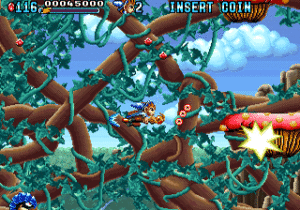 At only four levels, Mystic Riders was pretty short. Undoubtedly aware of that fact, Irem included a Ghouls ‘n Ghosts-style dynamic that had players go through the game again to achieve the “true” ending (which was virtually the same, save for a few messages). The game was markedly easier than other Irem shmups, so the task wasn’t overwhelming, particularly for two players. Mystic Riders was more forgiving and therefore could appeal to gamers who weren’t diehard shmup fans looking for a brutal challenge.
At only four levels, Mystic Riders was pretty short. Undoubtedly aware of that fact, Irem included a Ghouls ‘n Ghosts-style dynamic that had players go through the game again to achieve the “true” ending (which was virtually the same, save for a few messages). The game was markedly easier than other Irem shmups, so the task wasn’t overwhelming, particularly for two players. Mystic Riders was more forgiving and therefore could appeal to gamers who weren’t diehard shmup fans looking for a brutal challenge.
Available only in the Irem Arcade Hits collection, Mystic Riders is another title most players will experience only through emulation. I recommend doing so. It’s a short but fun ride with excellent presentation and gameplay that was overlooked by too many when it was released in 1992.
Ninja Baseball Bat Man (1993)
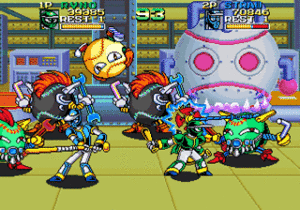 Likely the most well-known game on this list, Ninja Baseball Bat Man has rightly earned that distinction. The concept is downright nuts, but it works better than anyone would ever expect. It was designed by Drew Maniscalo, a National Sales Manager at Fabtek who combined Teenage Mutant Ninja Turtles with Batman to create baseball-themed heroes (literally “batmen”). The success of four-player arcade titles caused Mansicalo to expand the gameplay, and the result was an insane beat-‘em-up that was full of charm and interesting characters. The game didn’t try anything particularly new, relying on the combos and life-depleting attacks for which most fares of the period were known, but its look and style gave it some solid legs on which to stand. The cartoonish and colorful graphics meshed well with the character designs to create an identity that definitely should have attracted arcade-goers and made them spend a few quarters.
Likely the most well-known game on this list, Ninja Baseball Bat Man has rightly earned that distinction. The concept is downright nuts, but it works better than anyone would ever expect. It was designed by Drew Maniscalo, a National Sales Manager at Fabtek who combined Teenage Mutant Ninja Turtles with Batman to create baseball-themed heroes (literally “batmen”). The success of four-player arcade titles caused Mansicalo to expand the gameplay, and the result was an insane beat-‘em-up that was full of charm and interesting characters. The game didn’t try anything particularly new, relying on the combos and life-depleting attacks for which most fares of the period were known, but its look and style gave it some solid legs on which to stand. The cartoonish and colorful graphics meshed well with the character designs to create an identity that definitely should have attracted arcade-goers and made them spend a few quarters.
For some reason though, that didn’t happen. Reportedly, Ninja Baseball Batman sold extremely poorly outside of Japan. Chalk it up to a lack of advertising, public tastes focused on one-on-one fighters or just the slow death of western arcades, but Irem’s most unique brawler struck out upon release. It has only been through the wonders of emulation that the game has finally found an audience. I wholeheartedly recommend playing it; it’s an experience every gamer should try at least once, even if it’s just to see how such a whacky concept could even function as a coherent video game. It does, and it does well.
Superior Soldiers (1993)
As the only one-on-one fighter on this list, Superior Soldiers almost seems out of place among the armada of shmups surrounding it. Of course, Irem made quite a name for itself in the space shooting genre, many of which remain stranded in coin-op form, so it’s only natural that this list would lean that way. Irem certainly saw the shift in consumer tastes after Capcom’s massive success with Street Fighter II, making a fighting game a necessity. The game had a lot going for it including art designers that would eventually do graphics work on the Metal Slug series for the Neo Geo. Superior Soldiers would mark something of a turning point for Irem, as the company would soon dial back its coin-op output, causing several of those employees to leave and form Nazca Corporation, the company behind Metal Slug.
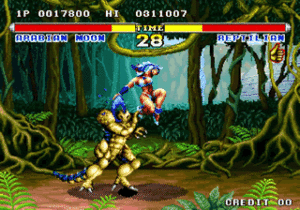 As Irem’s first attempt at a Street Fighter clone, Superior Soldiers was a clumsy one with some decent elements. The characters, for instance, were incredibly generic. Even for a group hailing from a post-apocalyptic landscape, they were an odd mix. A belly dancer, a superhero, a lizard man, and a samurai were just some of the playable fighters, and one could spend weeks trying to figure out how and why they would ever come together to fight. Thankfully, Superior Soldiers played well, using Capcom’s basic fighting controls as its inspiration but adding the double-tap dash attacks of SNK hits like Art of Fighting. Hardcore Gaming 101 described Superior Soldiers as “a game that feels like a Capcom fighter with the pace and art style of an early SNK fighter,” and I think that’s a spot-on assessment.
As Irem’s first attempt at a Street Fighter clone, Superior Soldiers was a clumsy one with some decent elements. The characters, for instance, were incredibly generic. Even for a group hailing from a post-apocalyptic landscape, they were an odd mix. A belly dancer, a superhero, a lizard man, and a samurai were just some of the playable fighters, and one could spend weeks trying to figure out how and why they would ever come together to fight. Thankfully, Superior Soldiers played well, using Capcom’s basic fighting controls as its inspiration but adding the double-tap dash attacks of SNK hits like Art of Fighting. Hardcore Gaming 101 described Superior Soldiers as “a game that feels like a Capcom fighter with the pace and art style of an early SNK fighter,” and I think that’s a spot-on assessment.
As with many Street Fighter II clones of this period, Superior Soldiers had decent gameplay that was overshadowed by multiple flaws, like dumb A.I. and the aforementioned questionable character designs. Together with stage designs that didn’t match the quality of the sprite artwork, the game was a sub-par experience that got lost in Capcom’s shadow.
That’s not to say that Superior Soldiers isn’t worth playing, though. I have a soft spot for poor fighting games. I view them as a window into a company’s design process, a good look at what designers thought was popular and how they sought to build on those concepts. Superior Soldiers is not anywhere near as bad as some of the other fighting games that flooded arcades in the mid-1990s, and it remains a fascinating example of Irem’s first steps into a new genre. Like so many of the games on this list, it too counts the Irem Arcade Hits as its only official port, so MAME is probably where gamers will first experience it. Try not to judge it from a modern perspective but rather how it compared to similar games of the era. You’ll find that it’s worthy of an afternoon or two, especially against a friend.
There you have it, not a comprehensive selection by any means but a good example of the games a great company like Irem left behind in the arcade. Many titles could be added to this list, and some readers may even think it shouldn’t be as long as it is. Such is the subjective nature of list-making, but the overall point still stands. As good as we had it during the 1980s and 1990s regarding arcade ports, so many more titles never got that chance. Some may have fared better on console than others, but darn would it sure have been fun to play them all.

Recent Comments